Blog / Steven Ramage / November 29, 2019
GEO Week 2019 has recently concluded in Canberra, however the decisions taken at the GEO Week Ministerial and Plenary will help guide the GEO community over the next four years and well into the future.
Here are some of my key takeaways fresh from Australia:
Firstly, it was hard not to be impressed the diversity and number of representatives that joined us in Canberra. In fact, this was the biggest ever GEO Week with over 1500 participants taking part in a range of events.


A dedicated effort to bring in youth and indigenous perspectives led to great outcomes, including a call from Indigenous representatives to work more closely and to bring Earth observations into communities. With dedicated awards from NASA and Scouts for young Citizen Scientists along with an open day for students to learn about careers in Earth observations, GEO Week made a concerted effort to have youth present at the event. At the GEO Week Plenary, NASA and the US delegation voiced their strong support for our push for more sustained and regular outreach with youth communities.


For those who could not join us in person, we had an engaged audience from around the world who tuned into our Livestreams on our Youtube channel. Be sure to catch up with all the Key Side Events, Plenary and Ministerial videos that have been archived here. And great efforts went into ensuring that all of the Side Event summaries are available online.
The brand new Industry Track was a highlight for many, including me. As our newest foray into engaging more closely with the commercial sector, the Industry Track, led by the Australian host, ensured that government representatives and partners from international organizations and non-governmental organizations could engage in discussion with companies. For example, the European Association of Remote Sensing Companies joined GEO Week to foster industry engagement. To learn more about EARSC and their involvement in Australia, read their blog post published last week.


Other features of GEO Week included the meeting of the UN Science Policy Business Forum which also took place in Canberra. It proved to be a great meeting of minds, as delegates were able to learn more about GEO and foster lasting dialogue between these two communities. The outcomes of the discussion will help shape the UN data strategy and relevant platforms and solutions that should facilitate transformational change for informed decision making, including the World Environment Situation Room platform.


There were excellent outcomes and new announcements on EO data policy. We saw both China and Japan making big announcements regarding newly available satellite data being opened for the first time. On the opening day of Plenary, China released details about Gaofen satellite data that is now available on an online portal. And Japan announced that they will be sharing radar satellite data and associated information from the Japan Aerospace Exploration Agency (JAXA) from their L-band Synthetic Aperture Radar (SAR), which can acquire images day and night and regardless of weather conditions.
Several countries made specific announcements to continue their support for GEO, including Australia’s support for a seconded expert to the GEO Secretariat, and the United Kingdom gave support for the continuation of GEO Global Agricultural Monitoring Initiative (GEOGLAM) Secretariat to be housed in Geneva. We saw increased engagement with Pacific Island Nations and Territories, at the Pacific Island Programme, and welcomed our first GEO Member country from the region, Tonga.


In terms of some big programme announcements, GEO launched with Google a new initiative to support GEO Members and Participating Organizations to access the Earth Engine. Stay tuned for details on how to apply. In addition, we also had Amazon offer web services to Digital Earth Africa (DE Africa) as part of the Amazon Sustainability Data Initiative (ASDI). Working closely with the AfriGEO community, stakeholders and partner organizations, DE Africa will address the information needs, challenges, and priorities of its users across the continent.
GEO also hosted a successful demonstration of the GEO Knowledge Hub proof of concept, and received general acceptance of the vision of a “results-oriented GEOSS.” These two initiatives have been led by the GEO Secretariat and continue to gain momentum.
GEO Week concluded in the best way possible. We saw Ministers from countries around the world endorse the Canberra Declaration. This is an ambitious plan to invest in open Earth observations to address the world’s greatest challenges related to Sustainable Development, Climate Change and Disaster Risk Reduction. This Declaration will act a roadmap for GEO’s future and we are grateful to the Ministerial Working Group, the Australian host Minister and everyone who worked together to ensure that this document reflected the views and ambitions of the global Earth observation community.


For those (like me) who enjoy Twitter you can pick up on a number of threads and discussion topics from Canberra by browsing #GEOWeek19
The photos are all available on Flickr. Here is one of my favourites of the GEO Week organizing team.


We intend to keep the momentum rolling as we head to South Africa next year for GEO Week 2020. We hope to see you in Port Elizabeth from 2-6 November, 2020.
About the author

Steven Ramage is Head of External Relations at the GEO Secretariat.
Thank you for your subscription to the GEO Week 2019 mailing list.